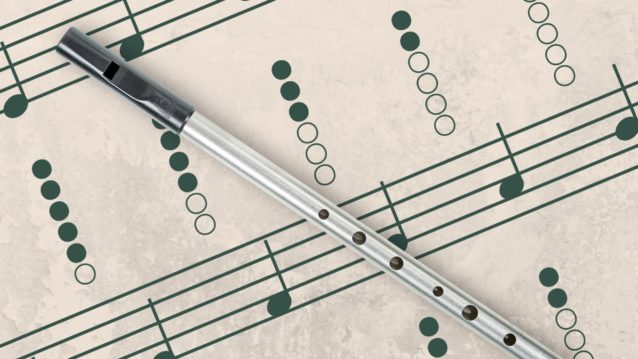In this lesson, we will cover one of the widely used note decorations for the Irish tin whistle (penny whistle), and that is the cut. As a beginner, if you tried to explore what you can achieve with the fingers on the whistle, you probably managed to do something very similar already. Cuts are arguably one of the easiest yet great sounding ornaments.
How to play cut ornament on a tin whistle correctly?
- You lift a finger and put it back to its hole.
- You do it as fast as possible.
The sound you want to hear is like pronouncing a very short “blah”, or “plah”. If you move the finger too slowly, you actually play two notes, and that’s what we want to avoid. A note decorated with a cut should have the same duration as if played without it. Therefore, make sure you are not lifting a finger too far, it’s just a quick transition. We find that the most common beginner “mistake” when doing a cut is its speed.
There’s one remaining piece of the puzzle, and that is to know which finger you particularly use to cut the note you are playing. While it’s logical to use the same finger which is playing the note itself, most of the players use a different finger instead. The vast majority agree that cut sounds crunchier. Thus that’s considered the correct way. You may come across advice that cuts should always be done with a finger above the note you are playing. For example, if you play a note E, you do the cut with the finger over the F# hole. However, there is another way, easier for beginners, that many other players use. And that is to use G finger (ring finger) for all of the notes from D to G and B finger for the remaining two.
Feel free to experiment and try the way that suits you best. Here’s a cheat sheet that explains which fingers to use to cut particular notes.
| Playing note | Cutting finger (hole) | Alternative |
|---|---|---|
| D | G | E, F# |
| E | G | F# |
| F# | G | – |
| G | G | A, B |
| A | B | – |
| B | B | – |
| C# | NONE | – |
Cut is not a “grace” note
Before we continue, there is one more important thing to point out. Speaking of the cuts in some other guides or books, you may come across the term “grace” note. This term comes from classical music and is usually written with a symbol of a little note added before the principal note, which literally means it is played somewhere before the principal note. To avoid any confusion, this is not entirely true. And the reason for this is that there is no common rule to transcribe the Irish traditional ornamentation into standard classical sheet music notation. The cut is not a grace note. It is rather an articulation of the principal note and is played simultaneously with the principal note itself.
When and why use cuts?
Technically, you can use a cut on repeated notes instead of tonguing. However, cuts are intended (as other ornaments) to emphasize important notes in a melody. They fit very well in Irish traditional music and often use many notes during a song or a tune. And also, one can easily say that cuts are a native ornament for woodwind instruments. Therefore you can hardly make a mistake no matter how much you are using it.
Preferably, you can use both tonging and cuts simultaneously, which gives a note an even crispier accent. Rhythmically wise, in reels, which usually have 8 times eighth note bar, a cut will sound really logical if used on notes 1, 3, 5, 7, etc. In jigs, which are 1-2-3 rhythmical phrases, a cut is mostly used on the first note.
Below is an example of using cuts in Chanter’s Tune where you can see how to play cuts on repeated notes. The second demonstration is the Kerry Polka, where we use cuts to emphasize the specific notes.
And here’s the sheet music and tabs for the previous video examples. The notes where we play cuts are marked with the letter “C”.


Practicing cuts on a tin whistle
Quite the opposite of slides, cuts are entirely independent of the tempo. The ornament itself should always sound the same, as fast as possible, no matter if a tune is a slow air or a fast jig. So, start practicing simple scales and then change the tempo on a metronome. You will find out soon that it’s much harder to play cuts correctly at a slower pace. But that’s good. If it’s hard, it only gets you to become better in the long run. Playing ornaments in fast tunes can be cheating, as moving fingers fast can easily be misinterpreted as an ornament, even if not done correctly.
The cut is entirely independent of the tune tempo. If played correctly, it always sounds the same, in both slow airs or fast jigs.
LearnTinWhistle.com
Another good example of tin whistle cuts
Liam O’Flynn hits the nail in the head in this Planxty’s live performance of the song “As I Roved Out”. And besides cuts, he does very nice rolls too (we’ll come to these soon). Brilliant playing style, enjoy!





Hello,
A question regarding both cuts and taps – is it acceptable to tongue the other notes if you feel they need emphasis or do you just blow the rest?
Hi Gail,
Yes, it’s absolutely fine to use tonguing based on your own feel, especially in the beginning. One “rule” that usually works well is this: if you have two repeated notes and the second one is a tap or a cut, it often sounds nice to tongue the first note before the ornament.
Hope that helps!
When it comes to using cuts, I have been trying to incorporate them in The Fields Of Athenry but without much success.
There are quite a few repeated notes and I seem to end up playing other notes instead of cutting.
Are some tunes just meant to have notes like tongued instead of cut?
Hi Graham,
A cut can be added on pretty much any repeated note. The question is just how it sounds in the context of the tune. Sometimes it’s really a matter of musical feel and personal taste. There isn’t a strict rule about when you should or shouldn’t use it.
Hello,
Which kind of ornamentation makes that great ‘TRRRR’ sound at the start of a phrase? For example in Mat Molloy’s playing of ‘Easter Snow’.
It almost sounds like tongueing and ornamentation together.
Thank you
Gail
Hi Gail,
That strong “TRRRR” sound at the start of a phrase is often done by mimicking the effect with the tongue — kind of like rolling an “R”. The flute allows for a bit more flexibility in that regard compared to the whistle.
When that is combined with a roll or cran on top, it can sound really prominent.